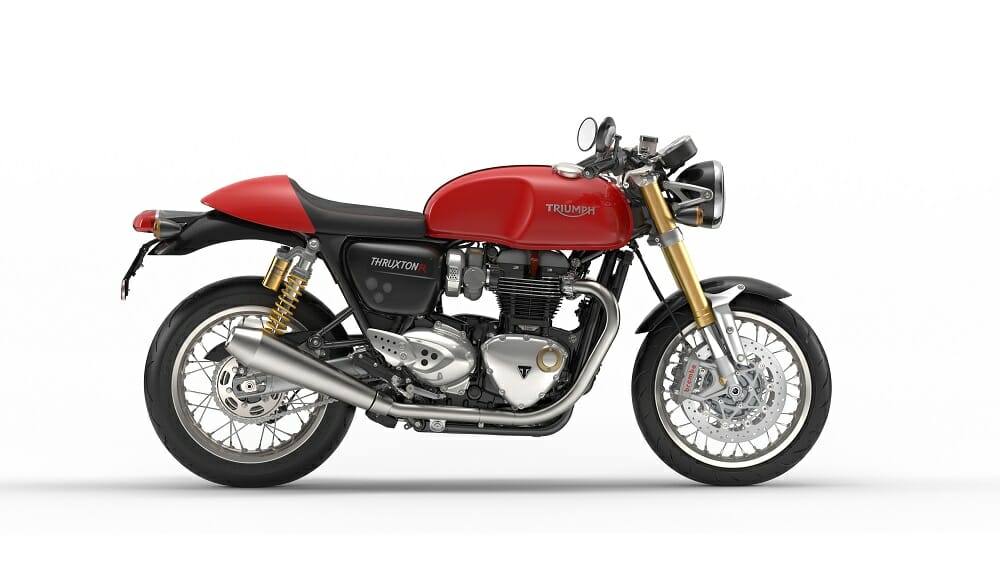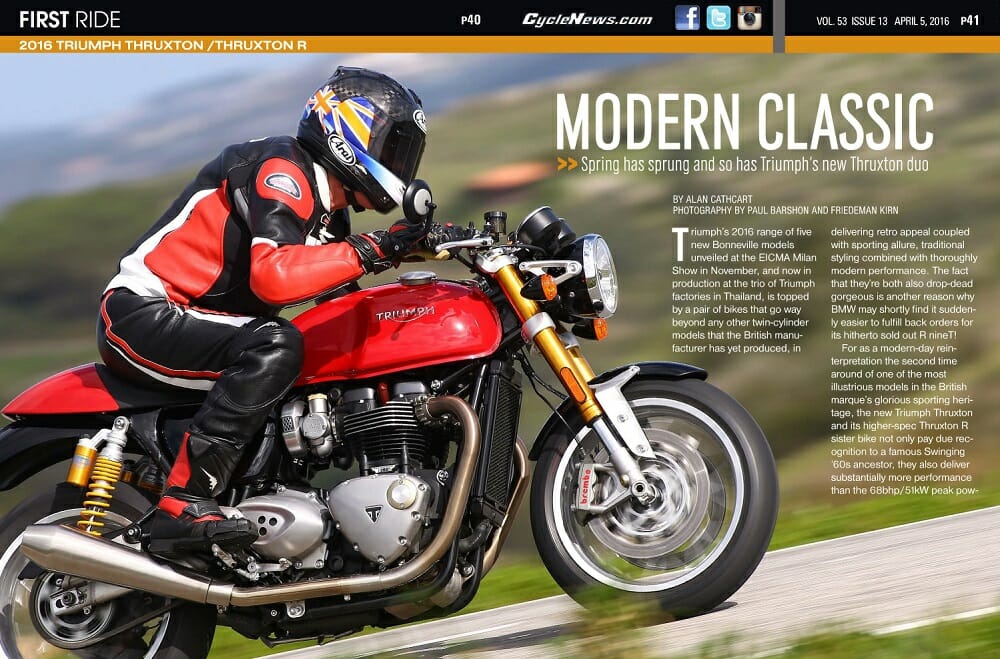
Spring has sprung and so has the new Thruxton R
Photography by Paul Barshon and Friedeman Kirn
Triumph’s 2016 range of five new Bonneville models unveiled at the EICMA Milan Show in November and now in production at the trio of Triumph factories in Thailand, is topped by a pair of bikes that go way beyond any other twin-cylinder models that the British manufacturer has yet produced, in delivering retro appeal coupled with sporting allure, traditional styling combined with thoroughly modern performance. The fact that they’re both also drop dead gorgeous is another reason why BMW may shortly find it suddenly easier to fulfill back orders for its hitherto sold out R nine T!
For as a modern-day reinterpretation the second time around of one of the most illustrious models in the British marque’s glorious sporting heritage, the new Triumph Thruxton and its higher-spec Thruxton R sister bike not only pay due recognition to a famous Swinging ’60s ancestor, they also deliver substantially more performance than the 68bhp/51kW peak power and 72Nm/53 lb-ft max torque produced by the original Bloor-era 865cc T100 Thruxton introduced in 2004 as a first attempt to pay tribute to the Way It Was. For the debut back then of the Thruxton 900 established Triumph’s formula for recreating the best of yesteryear but in a modern context performance-wise, and I may immodestly claim to have played a part in underlining that, by setting the current FIM World Land Speed Records for Unstreamlined Normally Aspirated twin-cylinder motorcycles back in 2009 with the Matt Capri-tuned Triumph Thruxton T100 (Click Link Here and then select “Rankings”).
NEW TECHNOLOGY
Now Triumph has produced two new generation sharper-handling, power-up Thruxton café racer versions of its brand new 1200cc T120 Bonneville base model. Thanks to its more affordable price and everyday nature this is expected to be Triumph’s bigger selling version, but the more costly Thruxtons won’t be far behind, loaded as they are with new technology, and powered by the same all-new liquid-cooled parallel-twin eight-valve 1200 engine shared with the T120. This comes with a 270° crankshaft and chain-driven single overhead cam replacing the 360° crank and twincam format of the outgoing smaller-cube T100 motor, and uses race-style finger cam followers rather than traditional bucket and shim valvegear. In so-called “High Power” Thruxton guise this larger capacity 1,197cc motor measuring 97.6 x 80mm produces improved performance over its HT—as in High Torque—T120 application, delivering 96 bhp/72kW at 6,750 rpm against the T120’s 79 bhp/59kW at 6,550 rpm. That’s 41% up on the previous T100 Thruxton motor, which is also 62% less torquey, while the new Thruxton duo’s peak torque of 112Nm at 4,950 rpm is also higher than the T120’s 105Nm. But that less sporty variant of the new Bonneville 1200 family has a broader spread of grunt peaking as low as 3,100 rpm, whereas the Thruxton duo build power and torque all through the rev-band up to near to the engine’s 7,500 rpm redline, 500 rpm higher than the T120. Yet in Thruxton guise the new 38% bigger engine is claimed to give 11% better fuel economy than the 865cc T100, at 61 mpg, allowing the sleek-looking 3.2-gallon fuel tank with traditional Monza flip-up filler hiding a lockable cap to deliver a 180-mile range. So, once again as with the new T120 Bonneville, the Thruxton uses less fuel in giving more performance.

NUMBER CRUNCHING
What all that number crunching means is that the new pair of Thruxton models are the most potent Bonnevilles to carry lights and a horn yet produced by Triumph, thanks to a performance increase over the T120 delivered by a lighter crank, higher compression (11:1 versus 10:1 for the T120), and a larger airbox, as well as revised mapping for the Keihin ECU. This has three riding modes available courtesy of the RBW/ride-by-wire throttle, versus just two on the T120 (which is already one more than the outgoing T100), since as well as that bike’s Road and Rain modes both Thruxtons now benefit from an extra Sport map. Switching modes on the move is a simple business—just close the throttle, press the M-button on the right ‘bar, then pull in the clutch to confirm the swap. Worth noting you must also hold in the clutch lever to start the Thruxton, even in neutral, though the clutch action is extremely light, denoting the presence of Triumph’s so-called “slip assist” design, which is their version of a slipper clutch, though with more engine braking left in than is usual with one of those.
All three modes produce the same peak power, but with a less intense delivery for Rain than Road, and for Road than Sport. In fact, Triumph was efficient enough to arrange for us to experience a serious rainstorm when riding the Thruxton R first time around at the Portuguese press launch held in the countryside north of Lisbon, where an hour of riding in the deluge revealed how effective the Rain map is in taming the undoubted performance of the bike. But next morning dawned bright and sunny, leaving us with ideal conditions to exploit the undoubted performance of the Thruxton R.
The R-model carries twin 320mm Brembo floating front discs gripped by the Italian firm’s four-piston Monoblock radial calipers, and operated by a Brembo radial master-cylinder with braided steel brake hoses, whereas the stock Thruxton has the T120’s twin-piston Nissin axial floating calipers gripping fixed Sunstar 320mm discs. That means the front suspension is different, too—although don’t assume that the gold-anodized fork tubes on the R-version mean the front end came from Sweden. So no, that isn’t an Öhlins fork, but a fully adjustable 43mm Showa BPF upside-downer, compared to the non-adjustable 41mm Kayaba cartridge fork on the base model Thruxton that’s sourced from the T120, and doesn’t have radial brake caliper mounting points. Both forks deliver 4.7 inches of wheel travel, same as at the rear where the Thruxton R has twin fully-adjustable piggyback Öhlins shocks against the base model’s twin Kayabas adjustable only for preload that are shared with the T120. Both Thruxtons feature an aluminum swingarm (silver anodized on the R) that differentiates the Thruxton duo from the T120 with its steel swinger.

The Thruxton R has several other detail improvements like a seat cowl, polished fork yoke, a metal tank strap and a pair of brushed stainless steel exhaust silencers rather than the chromed ones on the base Thruxton. This carries Pirelli Angel GT tires on its pair of 17-inch 32-spoke wire wheels with aluminum rims (versus the 18-inch front on the T120), while the same wheels on the R-version we rode carried Diablo Rosso Corsas, which aided by the standard switchable single-stage traction control and ABS, were surprisingly grippy in our wet-weather splasharound.

DRY RUN
But riding the Thruxton R the next day in dry conditions revealed this to be a bike that, as they say in Italy, was born well. Just sitting on it sets you smiling with anticipation, thanks to an extremely well-thought out riding position that didn’t prove tiring on our 100-mile trip into the Portuguese countryside, with the swan’s neck clipon Ace handlebars fitted here for the very same reason they were invented back in the Ace Café days 50 years ago, to give a sporty stance that isn’t a backbreaker. It’s wind cheating without being tiring, practical yet aggressive in that it invites you to tuck down behind the twin retro-style clocks on a fast, open stretch of road, but has a spacious enough seat for you to move back and forth on it, while also narrow enough where it meets the tank for shorter riders to be able to put a foot down at rest perfectly easily.
The good-looking fuel tank is well shaped, so you grasp it cozily with your knees, plus the retro-looking bar-end mirrors give a good view, and don’t vibe. At 31.9 inches the seat height is insignificantly taller on the Thruxton R than its sister bike’s (and nearly an inch higher than the T120’s), reflecting the taller rear ride height on the R thanks to the longer Öhlins shocks. This subtly changes the front-end geometry to give the Thruxton R a slightly sharper-steering setup, with a 22.8° rake to the Öhlins fork and 3.6 inches of trail, though both have the same short 55.7-inch wheelbase. Compare those figures to the T120 Bonneville’s 25.5°/4.1 inches/56.9 inches numbers to see how radical the Thruxton duo are in retro terms—these are essentially modern motorcycles wearing period dress, an authentic blend of tradition and topicality.

Twist The Throttle And Smile
For there’s nothing old-fashioned about the Thruxton R’s performance—though the bark from the Euro 4-compliant exhaust when you thumb the starter button is decidedly stirring, muscular even, in a traditional kind of way. Although thanks to the slipper clutch, there’s no need to blip the throttle on downshifts, I repeatedly caught myself doing so just to hear that great-sounding exhaust note. Thanks to the perfect primary balance of the 270° crank as well as the twin counterbalancers, there’s no hint of undue vibration at any revs—in spite of which this is an invigorating and involving motorcycle to ride, not a pseudo-electric one. It’s pretty torquey yet essentially a revver thanks to the lighter crankshaft—eager to build revs, yet dependable if you choose to ride the torque curve. Unlike the T120, whose wide spread of torque from low down makes it almost irrelevant which gear you throw at it, the Thruxton asks you to use the sweet-shifting six-speed gearbox (best yet on a Bonneville?) to keep the engine revving about 4,000 rpm, at which point the high-compression motor really takes off, building power up close to the hard-action 7,500 rpm limiter—it may be a ride-by-wire throttle, but Triumph has opted for an old-style cutout at the redline. Yet midrange roll-on from about 3,500 rpm upwards delivers a muscular response—you catch yourself reveling in the decisive pickup the big-twin motor delivers to the background track of twin-cylinder music. Riding the Thruxton in something approaching anger through a fast series of third-gear bends is heaven on two wheels, where in backing on and off the throttle you’re never disappointed at the response. This is an accessible and thoroughly enjoyable motorcycle which just asks to be ridden hard, and delivers when you do—but a wide-open powershifter would be very welcome to help keep it revving hard, even with the lighter crankshaft.

Chose Your Mode
The Sport riding mode has a crisp but controllable throttle response, and its fuel mapping is impeccable—it’s really well done. It’s responsive without being fierce or snatchy, even from a closed throttle, and in spite of the lightened crank. I ended up using it all the time, even in traffic. This makes the Road map pretty superfluous on the Thruxton, so it’s all the more irritating that when you switch off the engine it automatically defaults back to Road mode when you fire it up again. Why? “We want the selection of Sport to be a conscious act,” explained Nik Ellwood, Triumph’s Global PR Manager—the implication being that Thruxton riders need to be saved from themselves?! Come on, guys, it’s only a 96 bhp motorcycle, for goodness sake, and if your design team has done a good enough job to make the Sport map the go-to mode for everyday riding, we don’t need nanny to tell us different. Same on the other clock—each has a digital panel, which on the left-hand speedometer displays info that can be scrolled through via the “I” for Info button on the left handlebar, to access a mileage odometer, twin trips, fuel level, current and average fuel consumption, range to empty, a clock and a gear indicator. But if you prefer to have the clock on to keep track of time except when you want a specific piece of info, sorry—when you turn the engine off and start it again, it defaults to the odometer, so you must thumb through the choices again till you get back to where you were before. Nanny knows best!

THE SUSPENSION ISN’T KILLING US
Yet again, as on the T120 and also the Street Twin 900 I rode, the suspension on the Thruxton R was brilliantly set up—although this time with Showa/Öhlins hardware rather than the Kayaba package on those bikes. This tells you that the real credit goes to Triumph’s chassis development experts, the brothers David and Felipe Lopez, who, once again, have done a great job in producing a twin-shock motorcycle with outstanding suspension compliance at both ends. I was, once again, seriously impressed by the way the Triumph ate up the bumps. Yet when you do go over a rough stretch of road and the bike gets jiggled around, there are no rattles, just a tight and together feeling denoting the bike’s undoubtedly excellent build quality, which once again as on the T120 reflects well on Triumph’s Thai operation. The styling is great, too, as an effective blend of ancient and modern—the throttle bodies look like carburetors, and the cylinders have machined fins that according to Triumph actually do aid cooling, so the water radiator now fitted can be small enough to be visually insignificant, tucked away behind the front mudguard with barely a hose in sight. Worth noting the new Triumphs have LED lights front and rear, with a very distinctive signature light pattern for the front running light, and there’s a USB charging socket fitted as standard on the headstock for ready access.

FRAMED
The Thruxton duo share the same tubular steel main frame with the T120, but with a different welded-on sub-frame and a 1.2-inch shorter wheelbase thanks to their aluminum swingarm. With their 17-inch front wheel you get better feedback from the front tire than you do via the T120’s 18-inch front end, which in turn inspires confidence, especially in terms of keeping up turn speed. With a massive 21kg weight saving over the T120, the Thruxton R scaling a claimed 447 pounds dry feels beautifully balanced—riding it in town is anyway easy because of the light-action clutch, but it feels extremely maneuverable at low speeds in traffic. Yet this was a bike built to hit the highways and byways at speed, where the handling is really exceptional over most bumps, which the Italo-Japanese suspension package just shrugs off. The steering is light and agile, and the Brembo brakes work brilliantly well—again, there’s loads of feel, yet a very effective degree of stopping power, with good modulation via the adjustable lever if all you want to do is lose a little excess speed entering a fast sweeping turn. Nice.
Triumph has developed a range of more than 160 official accessories in total for the Thruxton duo, up to and including a range of Vance & Hines exhausts. Slightly strangely, both bikes come only as single-seaters with no option to take a passenger unless you buy the dual seat and passenger footrests that are only available as an accessory package. The BMW RnineT comes standard with pillion footpegs and passenger seat, so it’ll be interesting to see which company has a better understanding of what retrobike riders prefer to do when it comes to carrying a passenger on their bike. Triumph has also developed a trio of so-called ‘inspiration kits’ packaging several of the accessories together, including one called the Track Racer, which features an abbreviated café-racer-style half-fairing selling for GBP 1620 with all the trimmings, the unfaired Café Racer kit, and for the first time there’s a Thruxton R performance Race Kit for the bike that isn’t road legal in the UK.

And?
The new Thruxton R is a retro-styled café racer with modern performance, employing current technology in pursuit of today’s performance and handling, coupled with the allure of yesteryear. It’s a modern classic in every sense of the term, and I doubt very much that Triumph will be able to keep up with orders for it—especially once they start attracting conquest customers from other brands, some of them owners of modern sport bikes who are in for a surprise if they take a Triumph Thruxton R for a test ride. What a nice problem to have.

|
ENGINE: |
Liquid-cooled, 8-valve, SOHC, 270° crank angle parallel twin |
|
DISPLACEMENT: |
1200cc |
|
BORE X STROKE: |
97.6 x 80mm |
|
COMPRESSION RATIO: |
11.0:1 |
|
MAX POWER: |
97 PS/96 hp (72 kW) @ 6750 rpm |
|
MAX TORQUE: |
112 Nm @4950 rpm |
|
FUEL SYSTEM: |
Multipoint sequential electronic fuel injection |
|
EXHAUST: |
Chromed, 2-2 exhaust system w/twin chrome silencers |
|
FINAL DRIVE: |
X-ring chain |
|
CLUTCH: |
Wet, multi-plate assist clutch |
|
TRANSMISSION: |
6-speed |
|
EMISSIONS: |
Euro 4 |
|
FUEL CONSUMPTION: |
61 mpg |
|
FRAME: |
Tubular steel cradle |
|
SWINGARM: |
Twin-sided, aluminum / clear anodized |
|
FRONT WHEEL: |
32-spoke, 17×3.5 in. |
|
REAR WHEEL: |
32-spoke, 17×5 in. |
|
FRONT TIRE: |
120/70 ZR-17 in. Pirelli Angel GT / Pirelli Diablo Rosso Corsa |
|
FRONT SUSPENSION: |
Kayaba 41mm cartridge fork / Showa 43mm USD, fully adj. fork |
|
REAR SUSPENSION: |
Kayaba twin shocks w/adj. preload / Ohlins twin shock w/piggyback reservoir |
|
FRONT WHEEL TRAVEL: |
4.7 in. |
|
REAR WHEEL TRAVEL: |
4.7 in. |
|
FRONT BRAKE: |
Twin 310mm discs, Nissin 2-piston axial floating calipers, ABS / Brembo twin 310mm floating discs, Brembo 4-piston radial Monobloc calipers, ABS |
|
REAR BRAKE: |
Single 220mm disc, Nissin 2-piston axial floating caliper, ABS |
|
SEAT HEIGHT: |
31.7 in. / 31.8 in. |
|
WHEELBASE: |
55.7 in. |
|
RAKE: |
22.7° / 22.8° |
|
TRAIL: |
3.57 in. / 3.62 in. |
|
CLAIMED DRY WEIGHT: |
454.2 lbs. / 447.8 lbs. |
|
FUEL CAPACITY: |
3.3 gal. |
You can read the original magazine story by clicking HERE.

